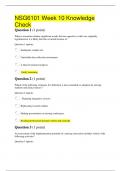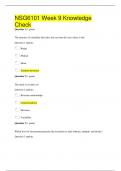NSG6101 (NSG6101)
South University
All 18 results
Sort by
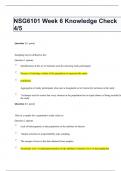
-
NSG6101 Week 6 Knowledge Check 4/5
- Exam (elaborations) • 4 pages • 2024
-
 TheInstructor
TheInstructor
-
- $10.89
- + learn more
NSG6101 Week 6 Knowledge Check 4/5 Question 1 (1 point) Sampling may be defined as the: Question 1 options: Identification of the set of elements used for selecting study participants Process of selecting a subset of the population to represent the entire population Aggregation of study participants who meet a designated set of criteria for inclusion in the study Technique used to ensure that every element in the population has an equal chance of being included in the stu...

-
NSG6101 Week 4 Knowledge Check.
- Exam (elaborations) • 4 pages • 2024
-
 TheInstructor
TheInstructor
-
- $10.49
- + learn more
NSG6101 Week 4 Knowledge Check. Question 1 (1 point) The overall purpose of a theory is to: Question 1 options: Explain relationships that exist among variables as well as the nature of those relationships Stimulate the generation of hypotheses that can be empirically tested Summarize accumulated facts Question 2 (1 point) The building blocks for theory are: Question 2 options: Propositions Relationships Hypotheses Question 3 (1 point) T...
NSG6101 Week 10 Knowledge Check correct answers provided
NSG6101 Week 9 Knowledge Check
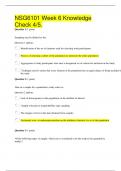
-
NSG6101 Week 6 Knowledge Check 4/5
- Exam (elaborations) • 3 pages • 2024
- Available in package deal
-
 grade_bender
grade_bender
-
- $13.00
- + learn more
NSG6101 Week 6 Knowledge Check 4/5
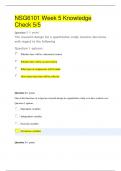
-
NSG6101 Week 5 Knowledge Check 5/5
- Exam (elaborations) • 3 pages • 2024
- Available in package deal
-
 grade_bender
grade_bender
-
- $13.10
- + learn more
NSG6101 Week 5 Knowledge Check 5/5
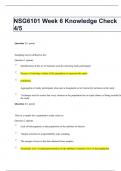
-
NSG6101 Week 6 Knowledge Check 4/5
- Exam (elaborations) • 4 pages • 2024
-
 QUICKEXAMINER
QUICKEXAMINER
-
- $9.49
- + learn more
NSG6101 Week 6 Knowledge Check 4/5 Question 1 (1 point) Sampling may be defined as the: Question 1 options: Identification of the set of elements used for selecting study participants Process of selecting a subset of the population to represent the entire population Aggregation of study participants who meet a designated set of criteria for inclusion in the study Technique used to ensure that every element in the population has an equal chance of being included in the stu...

-
NSG6101 Week 4 Knowledge Check.
- Exam (elaborations) • 4 pages • 2024
-
 QUICKEXAMINER
QUICKEXAMINER
-
- $11.49
- + learn more
NSG6101 Week 4 Knowledge Check. Question 1 (1 point) The overall purpose of a theory is to: Question 1 options: Explain relationships that exist among variables as well as the nature of those relationships Stimulate the generation of hypotheses that can be empirically tested Summarize accumulated facts Question 2 (1 point) The building blocks for theory are: Question 2 options: Propositions Relationships Hypotheses Question 3 (1 point) T...
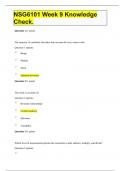
-
NSG6101 Week 9 Knowledge Check.
- Exam (elaborations) • 3 pages • 2023
-
 EXAMINER001
EXAMINER001
-
- $4.99
- + learn more
NSG6101 Week 9 Knowledge Check. Question 1 (1 point) The measure of variability that takes into account all score values is the: Question 1 options: Range Median Mean Standard deviation Question 2 (1 point) The mode is an index of: Question 2 options: Bivariate relationships Central tendency Skewness Variability

-
NSG6101 Week 4 Knowledge Check.
- Exam (elaborations) • 4 pages • 2023
-
 EXAMINER001
EXAMINER001
-
- $9.99
- + learn more
NSG6101 Week 4 Knowledge Check. Question 1 (1 point) The overall purpose of a theory is to: Question 1 options: Explain relationships that exist among variables as well as the nature of those relationships Stimulate the generation of hypotheses that can be empirically tested Summarize accumulated facts Question 2 (1 point) The building blocks for theory are: Question 2 options: Propositions Relationships Hypotheses Question 3 (1 point) T...

That summary you just bought made someone very happy. Also get paid weekly? Sell your study documents on Stuvia! Discover all about earning on Stuvia

